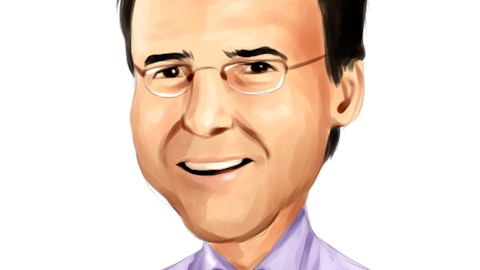Chris Shaw: I wanted to — I just want to get a handle on the quarter itself a little bit more. I guess what €“ internally, was the surprise for you on the cost side, the mix between franchise and company-owned stores? Or was it the sales I know sales growth was strong, but were you expecting something even stronger at some point? I’m just trying to figure out where the — maybe internally, you guys, kind of, missed.
Lori Flees: Sure. I’ll speak to it, and Mary can add. Relative to our internal plan, the piece that was not planned was €“ we had expected a base oil decreases to come through in our cost of goods. And when we pass on product cost to our franchisees. We have a very clear mechanism that is tied to the base oil index. And so as base oil index pricing is announced, we have very clear rules around how those get passed on to our franchise partners. When there is a lag on when we pass those versus when they materialize and through the inventory movement, when there is a gap that will cause a price or margin pressure to us. And in addition, we saw additive and delivery costs go up further than what the base oil index is going down, but those costs were going up.
Those were the two major things that we had not planned for. And so the team quickly put in some initiatives to mitigate those, both in the franchisee part of our business, but then also more broadly in our operations.
Mary Meixelsperger: And Chris, I would mention that our internal expectation, the mist was relatively modest, right around 5%. So it wasn’t a material miss in relationship to what our internal expectations were.
Chris Shaw: Got it. And then there was a reference to weather more about scheduling labor during the quarter. And I know that’s I’m sure it’s pretty typical of these quarters now, but was weather a meaningful impact at all this quarter? Or was it pretty similar to typical winter quarters?
Lori Flees: Well, we did have more weather in the Q4 than what we would typically see in that moved volume around. We saw more extreme weather in November in Minnesota and the Pacific Northwest.
Sam Mitchell: Our Q1.
Lori Flees: Our Q1, sorry, in the calendar quarter. But there was a bit of a push, because of the major freeze that happened right around Christmas that pushed a little bit of volume from the last week that we would typically see in December into January. So across the year, we feel good that we captured the demand, and we’re right on pace when we look at a rolling 30-days. But within the quarter, within the calendar quarter Q1, we hit our plan, but we were — we would have been pacing slightly over plan and vehicle served and overall sales than where we ended. But we feel really good how we started Q1.
Chris Shaw: Got it. Thanks, that’s helpful.
Operator: We have a follow-up from Mike Harrison from Seaport. Mike, please go ahead. Your line is open.
Mike Harrison: Hi, just a couple more for me. First of all, I’m intrigued by slide 13, where you break out the non-oil change revenue growth by quartile — maybe just give a little bit more color on, I guess, what you were seeing in terms of pricing and non-oil change revenue in the quarter and maybe non-oil change revenue improvement relative to your expectations?
Lori Flees: So on slide 13, on the right-hand side, we put in an initiative, and we did have that in our sales plan to actually improve our non-oil change revenue penetration. So we saw variation as we were working on our plan for the year and where we were going to drive sales growth and growth in profit and we saw a manual change penetration as an opportunity where our execution in some stores was not as consistent and leading to different outcomes from a non-oil-change revenue percentage of sales. So we went after that hard in our annual meeting and the company stores in October. And we reemphasized around presentation how to present the non-oil change services based on the success in our top quartile stores, and we basically rolled that out with all the store managers and then through the month of October, rolled that to every CSA or Customer Service Assistant in our store, so that they were consistently presenting the non-oil change services.
And what you see is a significant improvement in penetration across the system. And so the stores that were lagging have gotten more consistent. There’s still opportunity. Obviously, in retail, there’s opportunity every day to present better to the customer, but you can see a significant improvement.
Mary Meixelsperger: And Mike, it’s primarily driven by the penetration increase, not by pricing. We did do some pricing in non-oil change services that had a modest benefit, but where we really saw the biggest benefit was on the penetration because of the improved presentations.




